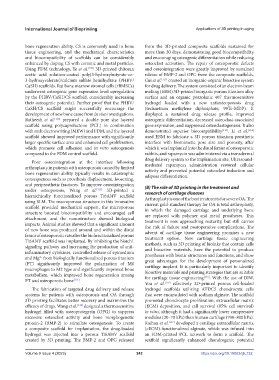Page 250 - IJB-9-4
P. 250
International Journal of Bioprinting Applications of 3D printing in aging
bone regeneration ability. CS is commonly used in bone from the 3D-printed composite scaffolds sustained for
tissue engineering, and the mechanical characteristics more than 20 days, demonstrating good biocompatibility
and biocompatibility of scaffolds can be considerably and encouraging osteogenic differentiation while reducing
enhanced by doping CS with ceramic and metal particles. osteoclast activation. The repair of osteoporotic defects
Using FDM technology, Ye et al. [109] 3D-printed chitosan and osseointegration were greatly improved by sustained
acetic acid solution-coated poly(3-hydroxybutyrate-co- release of BMP-2 and OPG from the composite scaffolds.
3-hydroxyvalerate)/calcium sulfate hemihydrate (PHBV/ Cui et al. [113] created an inorganic-organic bioactive system
CaSH) scaffolds. Rat bone marrow stromal cells (rBMSCs) for drug delivery. The system consisted of an electron beam
underwent osteogenic gene expression level upregulation melting (EBM) 3D-printed inorganic porous titanium alloy
by the PHBV/CaSH/CS scaffold, considerably increasing surface and an organic pozzolanic 407 thermosensitive
their osteogenic potential. Further proof that the PHBV/ hydrogel loaded with a new antiosteoporosis drug
CaSH/CS scaffold might successfully encourage the (technetium methylene diphosphate, 99Tc-MDP). It
development of new bone came from in vivo investigations. displayed a sustained drug release profile, improved
Ratheesh et al. [110] prepared a double pore size layered osteogenic differentiation, decreased osteoclast-associated
scaffold using polycaprolactone (PCL) in combination gene expression, and suppressed osteoclastogenesis. It also
with melt electrowriting (MEW) and FDM, and the layered demonstrated superior biocompatibility [113] . Li et al. [114]
scaffold showed improved performance with significantly used EBM to fabricate a 3D porous titanium prosthetic
larger specific surface area and enhanced cell proliferation, interface with biomimetic pore size and porosity, after
which promote cell adhesion and in vitro osteogenesis which it was implanted into the distal femur of osteoporotic
compared to the FDM control scaffold. rabbits, and rapamycin was administered via a transdermal
drug delivery system to the implantation site. Ultrasound-
Poor osseointegration at the interface following
arthroplasty in patients with osteoporosis caused by limited mediated rapamycin administration restored cellular
activity and prevented potential osteoclast induction and
bone regeneration ability typically results in catastrophic adipose differentiation.
consequences such as prosthesis displacement, loosening,
and periprosthetic fractures. To improve osseointegration (B) The role of 3D printing in the treatment and
under osteoporosis, Wang et al. [111] 3D-printed a research of cartilage diseases
hierarchically functionalized porous Ti6Al4V scaffold Arthroplasty is one of the best treatments for severe OA. The
using SLM. The macroporous structure in this innovative current gold-standard therapy for OA is total arthroplasty,
scaffold provided mechanical support, the microporous in which the damaged cartilage and underlying bone
structure boosted biocompatibility and encouraged cell are replaced with polymer and metal prostheses. This
attachment, and the nanostructure showed biological treatment is now approaching maturity, but still carries
impacts. Animal studies showed that a significant amount the risk of failure and postoperative complications. The
of new bone was produced around and within the distal advent of cartilage tissue engineering promises a new
femur of osteoporotic rats after the biofunctionalized porous treatment option. New cartilage tissue engineering
Ti6Al4V scaffold was implanted. By inhibiting the Notch1 methods, such as 3D printing of bioinks that contain cells
signaling pathway and increasing the production of anti- and bioactive materials, have the potential to produce
inflammatory cytokines, controlled release of epimedium prostheses with bionic structures and functions, and show
and Mg from biologically functionalized porous titanium great advantages for the development of personalized
2+
(PT) significantly improved the polarization of M0 cartilage implant. It is particularly important to identify
macrophages to M2 type and significantly improved bone bioactive materials and printing strategies that are suitable
metabolism, which improved bone regeneration among for cartilage tissue engineering [115] . With the use of DIW,
PT and osteoporotic bone [111] .
You et al. [116] effectively 3D-printed porous cell-loaded
The fabrication of targeted drug delivery and release hydrogel scaffolds utilizing ATDC5 chondrocyte cells
systems for patients with osteoporosis and OA through that were encapsulated with sodium alginate. The scaffold
3D printing facilitates better recovery and maximizes the promoted chondrocyte proliferation, extracellular matrix
efficacy of drugs. Wang et al. [112] designed a thermosensitive (ECM) deposition, and cell survival (85% cell survival)
hydrogel filled with osteoprotegerin (OPG) to suppress in vitro, although it had a significantly lower compressive
excessive osteoclast activity and bone morphogenetic modulus (20–70 kPa) than human cartilage (700–800 kPa).
protein-2 (BMP-2) to stimulate osteogenesis. To create Rathan et al. [117] developed a cartilage extracellular matrix
a composite scaffold for implantation, the drug-loaded (cECM)-functionalized alginate, which was infused into
hydrogel was injected into a porous Ti6Al4V scaffold an FDM-printed PCL network to form a scaffold. The
created by 3D printing. The BMP-2 and OPG released scaffold significantly enhanced chondrogenic potential
Volume 9 Issue 4 (2023) 242 https://doi.org/10.18063/ijb.732

